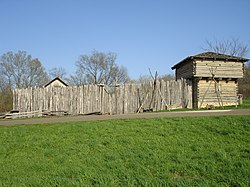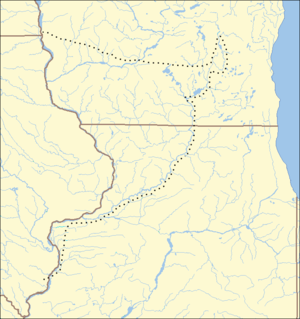Apple River Fort
Apple River Fort Site | |
Illinois State Historic Site | |
 Reconstruction of the fort | |
| Nearest city | Elizabeth, Illinois |
|---|---|
| Coordinates | 42°19′5″N 90°12′51″W / 42.31806°N 90.21417°W |
| Area | 0.5 acres (0.20 ha) |
| Built | 1832 |
| NRHP reference No. | 97001332[1] |
| Added to NRHP | November 7, 1997 |
Apple River Fort, today known as the Apple River Fort State Historic Site, was one of many frontier forts hastily completed by settlers in northern Illinois and southern Wisconsin following the onset of the 1832
Today, a replica of the fort stands next to the site of the original Apple River Fort. Constructed between 1996 and 1997 by a non-profit organization, the replica was based on earlier archaeological investigations of the site which revealed information about the layout and settlement at the fort. In 1997 the Apple River Fort Site was listed on the National Register of Historic Places, and in 2001 the state of Illinois took over operations of the site and designated it the Apple River Fort State Historic Site. Apple River Fort was one of numerous Illinois historic sites slated to close October 1, 2008, due to cuts in the Illinois budget by Governor Rod Blagojevich. After Blagojevich was impeached and removed from office, new Illinois Governor Pat Quinn reopened the site in May 2009.
History
Early history
The earliest settlers in the vicinity of Apple River Fort, probably miners, likely arrived more than a decade before the fort's construction. The miners settled the site and built log cabins around and near the Kellogg's Trail, a route from Galena to Dixon's Ferry; they obtained fresh water from a nearby spring.[2]
Black Hawk War background
| Map of Black Hawk War sites Symbols are wikilinked to article |
The fort's construction was motivated by the Black Hawk War, which was a consequence of an 1804 treaty between the Governor of the
After the discovery of lead in and around Galena, Illinois, during the 1820s, miners began moving into the area ceded in the 1804 treaty. When the Sauk and Fox returned from the winter hunt in 1829 they found their land occupied by white settlers and were forced to return west of the Mississippi River.[4] Angered by the loss of his birthplace, between 1830–31 Black Hawk led a number of incursions across the Mississippi, but was persuaded to return west each time without bloodshed. In April 1832, encouraged by promises of alliance with other tribes and the British, he again moved his so-called "British Band" of around 1,000 warriors and non-combatants crossed the river into Illinois.[3] Finding no allies, he attempted to return to Iowa, but the undisciplined Illinois militia's actions led to the Battle of Stillman's Run.[5] After the first clash at Stillman's Run, construction at the Apple River Fort site advanced quickly.[6][7] A number of other engagements followed, and the militias of Michigan Territory and Illinois were then mobilized to hunt down Black Hawk's Band.
Construction

The Apple River Fort was constructed by the early settlers in the region in present-day Elizabeth, Illinois, for protection during the 1832 Black Hawk War.[8] At the onset of the Black Hawk War, settlers in southern Wisconsin and northern Illinois constructed a series of forts, stockades, and fortified homes; Apple River Fort was one of the forts erected after the Illinois Militia's defeat at Stillman's Run on May 14.[6][7] The Galenian newspaper reported that the blockhouse was finished on May 22, 1832, with the stockade completed several days later. A militia company was formed from among the local families and single men and boys. This unit elected local surveyor and land-owner Clack Stone, as captain and commander of the settlement's militia contingent.[9] The Apple River settlement, at the time of the fort's completion, was home to several families who had traveled long distances: the Crains, the Armstrongs, and others. Some families, like the Flacks, the Howards, and Lawhorns and others took up residence in nearby cabins. The Murdock family already resided in a homestead near the new fort.[7][9] Relatively few contemporary descriptions of the fort exist. One of the more complete later descriptions—and the only one to mention the blockhouse in detail—is found in the 1878 post-Black Hawk War text The History of Jo Daviess County:
Trees were felled, and dragged to the area to be enclosed. A three foot trench was dug along the proposed stockade line. each post was raised into place and back-filled to hold the timber erect and projecting about twelve feet high, One corner of the fort was formed by using two walls of an existing log house in which one of the settlers had lived. In the opposite corner, was built a " block house," of two stories, with the upper story most likely constructed on top of an existing agricultural outbuilding. The second story projecting over the other about two feet, so that the Indians could not come up near to the building for the purpose of setting it on fire, without being exposed to the guns of the settlers, from above. On one side of the yard were two extant long cabins, for dwelling purposes, and in the two corners not occupied by houses, elevated benches were built into "bastions" or outward projections in the log wall. These were made to stand upon and reconnoitre.[10][11]
Battle of Apple River Fort
The fort was attacked by
After the war
After the war ended, the fort remained standing into the 1840s; in the immediate aftermath of the war's conclusion the site was occupied by two
The state historic site at the Apple River Fort Site was set to close October 1, 2008, because of cuts in the
Archeology

The Apple River Fort Historic Foundation began attempting to locate the original site of the fort in the spring of 1995. Local tales told of the fort being situated on a hill not far from Main Street in Elizabeth. The group, unable to determine the veracity of the tale, hired an archaeologist to determine the location of the old frontier fortification.[4]
The
The archaeologists' efforts at the fort site allowed for the construction of a replica beginning in 1996. Volunteers built the fort, using the same tools and materials settlers would have used.[4] Logs were stripped and split by hand, shingles were split by hand, and a trench dug to connect the two cabin replicas on the interior. The stockade walls were built using 14 and 15 foot (4.6 m) long logs. In addition, volunteers completed a blockhouse and firing stands with hand-hewn ladders.[4]
Design
During the archaeological investigation at the site, Apple River Fort was found to display a nearly identical construction pattern to that of Fort Blue Mounds, another Black Hawk War frontier fort near present-day Blue Mounds, Wisconsin.[6] The major difference between the two structures was in the placement of buildings within the stockade walls.[6][17] The digs at Apple River uncovered a dozen original features of Apple River Fort. The remains of four cellars were found within the fort, one in southeast corner of the fort may have been used for food storage or as a dairy-processing pit. In the northwest corner of the fort, there were two more cellars, just west of one of the fort's log buildings. The largest cellar was located beneath the fort's blockhouse, in its southeast corner, and was used as a trash pit into the 1840s. The blockhouse cellar yielded the earliest archaeological material collected at the site.[18]
Significance
The Apple River Fort played a role in the 1832 Black Hawk War, being one of the few forts that was attacked during the conflict, and the only fort attacked by a band led by
See also
Notes
- ^ a b "National Register Information System". National Register of Historic Places. National Park Service. March 13, 2009.
- ^ a b c d Harmet, pp. 5-9.
- ^ a b c d Lewis, James. "The Black Hawk War of 1832 Archived 2009-08-15 at the Wayback Machine," Abraham Lincoln Digitization Project, Northern Illinois University. Retrieved September 12, 2008.
- ^ a b c d e f g h "Apple River Fort Archived 2007-09-05 at the Wayback Machine," Historic Sites," Illinois Historic Preservation Agency. Retrieved September 12, 2008.
- ^ "May 14: Black Hawk's Victory at the Battle of Stillman's Run Archived 2007-08-14 at the Wayback Machine," Historic Diaries: The Black Hawk War, Wisconsin State Historical Society. Retrieved September 12, 2008.
- ^ a b c d Birmingham, Robert. "Uncovering the Story of Fort Blue Mounds," Wisconsin Magazine of History, Spring 2003. Retrieved August 13, 2007.
- ^ a b c "June 24, Elizabeth, Ill.: Women Save the Apple River Fort," Historic Diaries: The Black Hawk War, Wisconsin State Historical Society. Retrieved August 13, 2007.
- ^ "Elizabeth History Archived 2007-06-23 at the Wayback Machine," Past To Present - Mining To Farming, Elizabeth Chamber of Commerce. Retrieved August 13, 2007.
- ^ a b c d Harmet, p. 14.
- ^ Kett, H.F. and Co. The History of Jo Daviess County, Illinois, (Google Books), H.F. Kett & Co., Chicago: 1887, p. 583. Retrieved August 13, 2007.
- archaeological digsshowed that the dimensions given in this 1878 description were incorrect. See Harmet, p. 5.
- ^ Newton, P. Carter. "Fort's Closing Archived 2011-07-11 at the Wayback Machine", Galena Gazette, September 9, 2008, accessed September 11, 2008.
- ^ Garcia, Monique and Gregory, Ted. "State park closings a tough pill for some to swallow", Chicago Tribune, November 29, 2008, accessed April 12, 2009.
- ^ "Governor Quinn calls on IDNR to Reopen State Parks Archived 2009-04-08 at the Wayback Machine", (Press release), Illinois Department of Natural Resources, February 26, 2009, accessed April 12, 2009.
- Huffington Post, March 25, 2009, accessed April 12, 2009.
- ^ a b c d Harmet, pp. 16-20.
- ^ Harmet, p. 23.
- ^ Harmet, pp. 7-8.
- ^ "Apple River Fort newest historic site Archived 2006-09-10 at the Wayback Machine," News, Illinois Heritage Fall 2001, Vol.4, No. 1. Retrieved August 13, 2007.
References
- Harmet, A. Richard. "Apple River Fort Site, (PDF), National Register of Historic Places Nomination Form, March 31, 1997, HAARGIS Database, Illinois Historic Preservation Agency. Retrieved August 13, 2007.
Further reading
- Hall, Jonathan N. Reconstructed Forts of the Old Northwest Territory. Westminster, Md: Heritage Books, 2008. ISBN 9780788447761
External links
- Apple River Fort State Historic Site
- The Guns of Apple River Fort (Archived 2009-10-25): Analysis of archaeological data
- Fort Tours: Apple River Fort, IL



